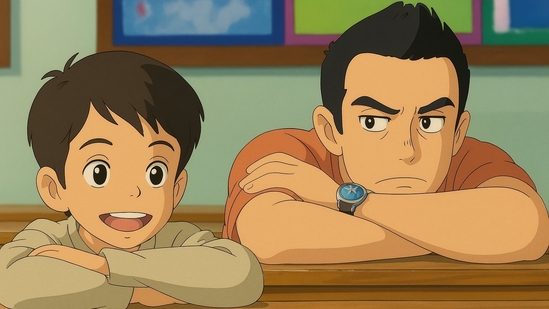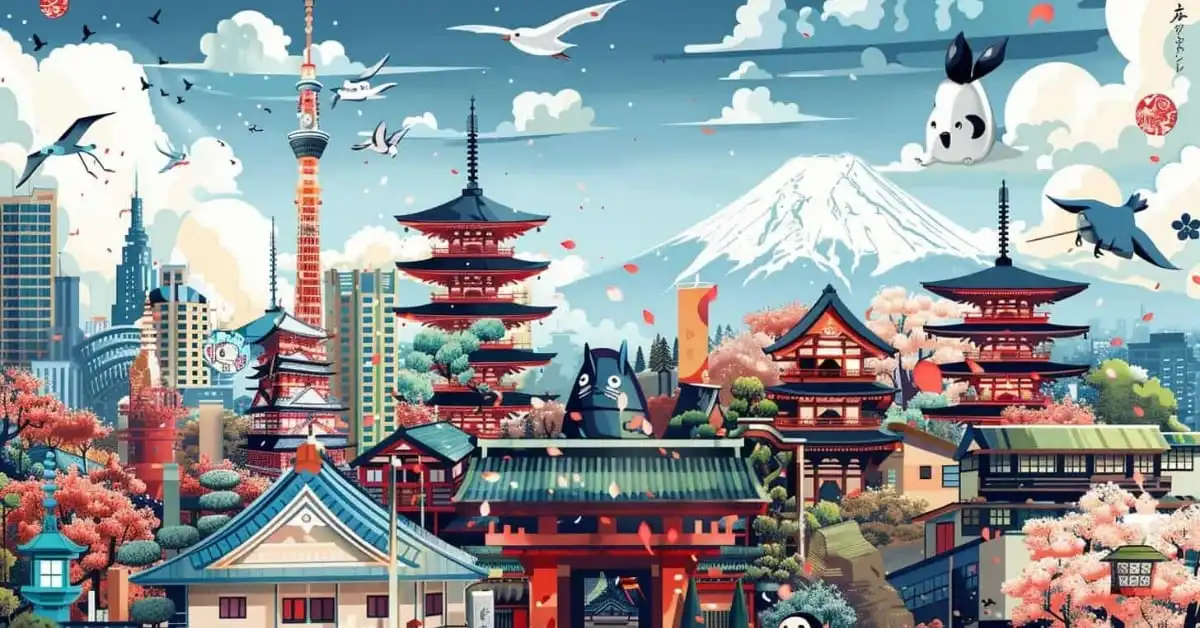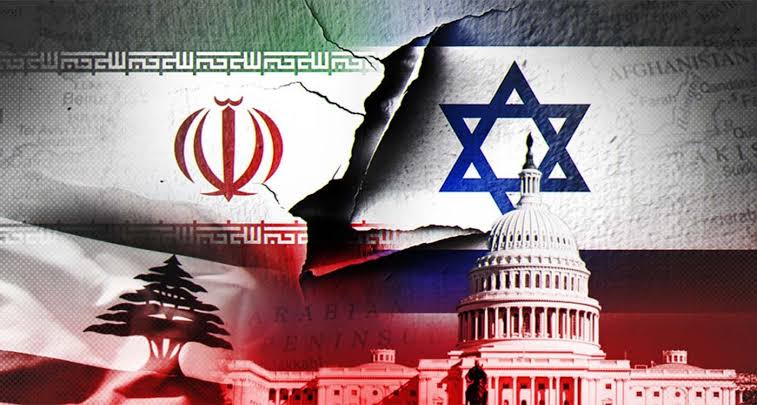Recently, you might have noticed Studio Ghibli-style artwork taking over social media. From Elon Musk to ministers, influencers, and news channels—everyone is sharing breathtaking Ghibli-inspired visuals. While it seems like a sudden trend, Ghibli Art is not something AI has created on its own. Watching this trend grow has been fascinating, but there has always been a bigger picture related to Japan’s soft power behind it.

What is Studio Ghibli Art, and Who Created It?
Studio Ghibli Art refers to the unique animation style seen in films by Studio Ghibli, a famous Japanese animation studio founded in 1985 by Hayao Miyazaki, Isao Takahata, and Toshio Suzuki. This style is known for its stunning landscapes, hand-drawn animation, deep storytelling, and a nostalgic, whimsical feel. Iconic films like My Neighbor Totoro, Spirited Away, and Howl’s Moving Castle showcase this artistic magic, influencing artists and animators around the world.
From Doraemon to anime, to cuisines, to Studio Ghibli, to fashion wear, these are all part of Japan’s larger strategy of cultural diplomacy and soft power. Let us explore in this article the strategy Japan has mastered for decades.
Let’s first see what Soft Power is…
What is Soft Power?
American political scientist Joseph Nye introduced the concept of soft power in 1990, defining it as “a country’s ability to influence others through attraction rather than coercion or force.” Unlike hard power, which relies on military strength, soft power shapes global influence through culture, political values, and foreign policy.
Key elements of soft power include:
- Culture: example:- Japan’s anime, J-pop, or Studio Ghibli Art.
- Political values:– example: Democracies like the U.S., India, and Germany influence other nations through governance and institutions.
- Foreign policy:– example: India’s role as a security provider in the Indian Ocean, peace keeping, and humanitarian efforts.
(Also Read: Indo-Pacific Geopolitics: Exclusive Insights from Carlyle Thayer on Regional Dynamics and Strategy Challenges)
Japan’s Cultural Diplomacy
“Japan’s strength is its culture, its traditions, and its values. These are the foundation of our soft power, which brings people from all over the world closer to Japan.” — Late Shinzo Abe (Former Prime Minister of Japan)
Through strategic cultural diplomacy, Japan has become a major global influence, especially in Asia. While other countries focus on military strength, Japan has invested in its rich cultural heritage, shaping global perceptions through attraction rather than force.
As of 2025, Japan ranks fourth in the Global Soft Power Index by Brand Finance, just behind the United States, China, and the United Kingdom.
Despite having an aging population and a struggling economy—Japan’s GDP growth was only 0.9% in 2024—the country continues to hold its place among world powers like the U.S. and emerging nations like China and India. This is largely due to its strong soft power, built on culture, technology, and diplomacy.
Japan’s Soft Power Strategy: A Historical Perspective
Japan’s soft power approach has evolved significantly since World War II. The 1977 Fukuda Doctrine promoted a “heart-to-heart” partnership in diplomacy. In the 1980s and 90s, Japan became a leader in technology, making high-quality cars, electronics, and entertainment that strengthened its global image.

Post-War to 1980s: The Foundations of Japan’s Soft Power
After World War II, Japan rebuilt itself into an economic powerhouse. By the 1960s and 70s, brands like Sony, Toyota, and Honda became symbols of quality worldwide. Japan’s technological leadership set the stage for a broader cultural influence.
The 1990s: The Rise of ‘Cool Japan’
Despite an economic downturn in the 1990s, Japan’s cultural impact soared. This period saw the rise of Cool Japan—a strategy that leveraged Japan’s unique aesthetic and creative industries.
Anime and manga became powerful cultural exports. Global hits like Dragon Ball, Sailor Moon, and Pokémon introduced audiences to Japanese storytelling and art styles. I can recall that the only anime I’ve ever watched is ‘Grave of the Fireflies‘ (1988), a Studio Ghibli masterpiece. The storytelling hit me so hard that, from that day on, I could never call anime just “cartoons” again!
Japanese video games also gained global dominance. Nintendo and Sony Playstation revolutionized gaming, while franchises like Final Fantasy and Mario became household names. These games introduced unique Japanese storytelling elements to the world.
Japanese fashion also gained international attention, with designers like Issey Miyake and Yohji Yamamoto challenging Western styles. Minimalist Japanese design influenced global architecture, interiors, and products.
Japanese cuisine became mainstream worldwide. Sushi, once considered exotic, is now common in cities across the globe. The popularity of dishes like ramen reflects Japan’s culinary soft power.
2006: The Official Recognition of Pop Culture Diplomacy
Japan formally embraced pop culture as a diplomatic tool in 2006. The Ministry of Foreign Affairs (MOFA) launched Pop Culture Diplomacy, making anime, manga, video games, and fashion key parts of Japan’s global strategy. Foreign Minister Taro Aso, a crazy manga fan, introduced the International MANGA Award and positioned pop culture as a core aspect of Japan’s diplomacy.
The government backed this with the Cool Japan campaign, funding the promotion of Japanese media, fashion, food, and culture. The Ministry of Economy, Trade, and Industry (METI) set up the Creative Industries Promotion Office to coordinate these efforts, while organizations like the Japan Foundation and JETRO facilitated global connections for Japan’s creative industries.
As a result, anime conventions grew worldwide, J-pop and J-dramas gained international fans, and Japanese aesthetics influenced fashion and design. Even Uniqlo, a Japanese brand, has made its mark globally.
Challenges to Japan’s Cultural Diplomacy
Looking ahead, Japan faces major challenges in sustaining its cultural influence:
- Aging population: With fewer young creators, maintaining cultural exports might become harder.
- Economic struggles: Limited growth (only 0.9% in 2024) makes funding cultural diplomacy more difficult.
- Rising competition: South Korea, China and India are growing their own soft power, making global influence a tougher battle.
- Keeping up with trends: Balancing tradition with modern technology and global tastes is an ongoing challenge.
Conclusion
The recent surge of AI-generated Studio Ghibli Art proves just how deeply Japan’s cultural influence is embedded in the global imagination. While the internet is filled with breathtaking Studio Ghibli-style landscapes, what truly stands out is how effortlessly Japan’s soft power continues to shape global trends. Unlike nations that rely on political or military dominance, Japan has mastered the art of winning hearts through culture, creativity, and storytelling.
But Japan’s soft power is not a static force-it requires constant adaptation. As Japan faces economic struggles and demographic shifts, the challenge lies in keeping its cultural exports relevant and engaging for future generations. Trends will come and go, but the essence of Japanese soft power-its ability to inspire, connect, and create a sense of wonder-remains timeless.
So, whether it’s through AI recreations of Studio Ghibli magic, the global love for sushi, or the ever-growing influence of anime, Japan continues to prove that true power isn’t just about strength-it’s about the stories you tell and the emotions you leave behind.





[…] Also Read: Japan’s Soft Power: Ghibli Art, a Part of Their Cultural Diplomacy […]
[…] Also Read: Japan’s Soft Power: Ghibli Art, A Part Of Their Cultural Diplomacy […]